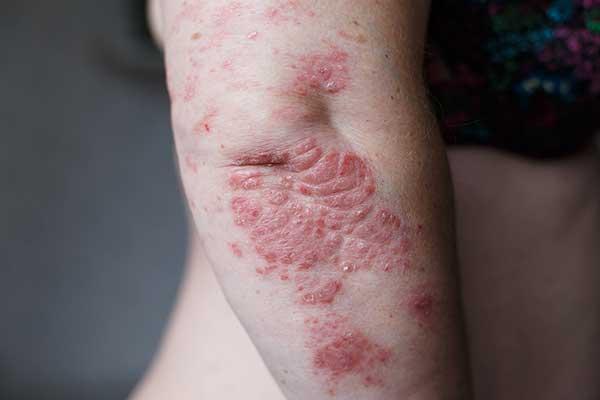Psoriasis : Challenges, Causes, Symptoms, Diagnosis and Treatment

Psoriasis is a skin disorder that causes skin cells to rapidly multiply, forming dry, itchy patches that are red and often painful. It can be a challenging, chronic disease that may escalate and then subside, depending on the circumstances causing your flare-ups.
While the symptoms of psoriasis can fade on their own, with or without medical treatment, and not appear for long periods of time. However, its recurrence is unpredictable and often goes through cycles of improvement and degeneration.
There is no cure for this disease, but it can be managed.
Psoriasis Diagnosis
The symptoms of this disorder can show up differently on people.
The hallmarks of psoriasis can occur in varied parts of the body, such as on the elbows, arms, legs, scalp, nails, armpits, or genitals.
Some of the symptoms of psoriasis are:
- Reddened patches of skin that are covered with silvery scales
- Dry skin that is cracked and sometimes bleeding
- Itching
- Burning
- Pain or soreness
- Thickened or ridged nails
- Small spots covered with scales, especially in children
Your physician can diagnose psoriasis by reviewing your medical history, looking at your skin, and sometimes by taking a skin biopsy.
Usually, a simple examination of your skin, scalp, or nails is all that is needed for your doctor to give you a diagnosis.
There are different types of psoriasis, so knowing which type is affecting you will help determine the type of treatment your physician or you, yourself, can begin.
Types of Psoriasis
The various types of psoriasis include:
Plaque: The most common type, also known as psoriasis vulgaris. The raised, inflamed patches can appear on elbows, knees, scalp, and the lower back.
Guttate: Less common, and often begins in children or young adults. Causes small, pinkish spots on the trunk, upper arms, scalp, and thighs.
Pustular: Quite uncommon, causes pustules to appear usually on the hands or feet. If it occurs on most of the body, it is called generalized pustular and can become serious, needing immediate attention.
Inverse: The red patches are bright, not raised, and shiny, without scales. Inverse psoriasis normally shows up on armpits, around the groin, beneath breasts, and in skin folds.
Erythrodermic: Least common, but serious. This type affects most body areas, making skin look as though it’s been burned, with severe itching, peeling, and changes in body temperature. Erythrodermic psoriasis needs medical treatment immediately as it can lead to serious infections or congestive heart failure.
Nail: Common in those who have psoriasis, especially psoriatic arthritis. The nails become pitted, tender, can separate from the nail bed, change color, and increase the likelihood of fungal infections forming.
Psoriatic Arthritis: Occurs in those suffering from both psoriasis and arthritis. Many people with a decade-long history of psoriasis develop this form of the disease, along with nail changes. Joints become painful, swollen, and stiff.
Psoriasis Treatment
Psoriasis symptoms can be treated in a variety of ways, often depending upon which type of the disease you have.
The main goal of treating this skin disorder is to stop the skin cells from multiplying so fast, which will reduce the inflammation and slow the formation of plaques. It’s also desirable to remove the scales and smooth the skin with topical ointments.
Topical Treatment
You can treat mild or moderate symptoms with creams that help relieve the itching, burning, and redness. But when your symptoms are more severe, your doctor will likely supplement these ointments with oral medications or a form of light therapy.
Corticosteroid ointments are powerful anti-inflammatory agents that slow cell turnover to reduce inflammation and itching.
Depending upon the severity of your symptoms and where on your body the patches are forming, your physician may prescribe either low-potency or stronger corticosteroid creams, foams, or scalp solutions.
There are other types of creams to help treat psoriasis. Some of them may contain either vitamin D, Anthralin, topical retinoids, calcineurin inhibitors, salicylic acid, or coal tar.
Light Therapy
Exposing the skin to a certain amount of natural sunlight also helps reduce cell turnover, scaling, and inflammation.
The sun’s ultraviolet (UV) rays work with brief exposures on a daily basis. Before starting this type of therapy, ask your doctor about its safety for your condition and the length of time you should spend exposing your skin to UV rays.
See Also: Skin Cancer: Are You at Risk?
Using an artificial light source with controlled doses of UVB light can help symptoms of mild or moderate psoriasis, especially when followed up with a moisturizing cream.
Narrow Band UV Therapy is professionally administered a few times a week until improvement in skin is shown.
A combination of UVB treatment and coal tar treatment called Goeckerman treatment requires a hospital stay. The combination of treatments makes the skin accept the UV light treatment more readily.
Photochemotherapy uses a light-sensitizing medication that is taken before UVA light exposure to allow the light to better penetrate the skin.
Excimer Laser Therapy is a type of light therapy using a controlled beam of UVB light directed at only the skin that is affected. Fewer sessions than other types of phototherapy are required.
Psoriasis Medications
When you’ve tried these treatments and they aren’t working, or if your psoriasis is severe, your doctor might decide to prescribe certain oral or injected drugs that are used for just brief periods of time, alternating with other forms of treatment.
Retinoids, a type of vitamin A, and methotrexate drugs help slow down skin cell production. Cyclosporines suppress the immune system, but this, in turn, can lead to other health problems, such as infections.
There are other medications that alter the immune system to treat moderate to severe psoriasis. They can be given by injection or by intravenous infusion and are normally used for those who don’t respond to other, more traditional therapies.
Psoriasis Lifestyle and Self-Help Remedies
Baths: Take a daily, lukewarm bath, to which you add either bath oil, Epsom or Dead Sea salts, or colloidal oatmeal. Use only mild soaps that have no added oils or fats. This will aid in removing scales and calming skin that is inflamed.
Moisturize: After bathing, just lightly dry your skin by blotting with a towel. Next, quickly apply an oil- or ointment-based moisturizer to your still-damp skin.
Sunlight: First ask your physician how much time you should expose your lesions to direct sunlight. Then get out into the sunshine on a daily basis, if possible, to treat your skin, while applying a sunscreen with a high SPF to your healthy skin areas.
Avoid Triggers: Certain events or lifestyle habits may be triggering your outbreaks. Discover what they are by tracking your symptoms and what’s happening in your life, then do what you can to prevent or avoid those triggers. Psoriasis can be exacerbated by exposure to infections, skin injuries, stress, smoking, and excessive sun exposure.
Alcohol: Limit your consumption of alcohol, as it can make some psoriasis treatments less effective.
Aloe Vera: This natural extract from the aloe vera plant can reduce your symptoms. Use it a few times a day for at least 30 days to see if your skin shows improvement.
Fish Oil Supplements: These omega-3 fatty acids might be able to reduce your inflammation. A safe dosage is 3 grams or less per day.
Oregon Grape: You can apply topical ointments made of Oregon grape or barberry to ease symptoms.
Quality of Life Help
Living with psoriasis can certainly become a challenge if flare-ups occur often and do not go away without intense interventions.
Research scientists are constantly working on solutions and coping strategies for living with this disease. Some of the more concerns for those suffering from psoriasis include learning how to deal with stress, a common trigger for flare-ups.
Stress-reduction techniques can help manage inflammation, which is how the body copes with stress.
Consider learning meditation movement and breathing to relieve stress. Exercise can decrease stress through the production of endorphins, which are chemicals that lighten mood and increase energy, help with sleep, and decrease anxiety.
Itching can affect your quality of life. It’s a symptom that becomes visible to others and can cause stress and anxiety.
Take cool showers or use cold packs. Try Calamine lotion, Hydrocortisone and other anti-itch creams if you’re not using prescription treatments.
Be sure to keep your skin moisturized and use scale-removing over-the-counter lotions to make anti-itch creams work better.
Your symptoms of psoriasis may disappear by themselves or possibly diminish after years of treatment. Psoriasis can also become a long-term condition that you may keep under control using a regimen designed by what you know works and what your physician has prescribed.
Sometimes it’s possible to escape intensive treatment for mild to moderate psoriasis if you know what triggers your flare-ups and then try to avoid those situations.
If you consider making some lifestyle changes, and treat your symptoms with over-the-counter topical ointments, you may be able to control psoriasis successfully.




